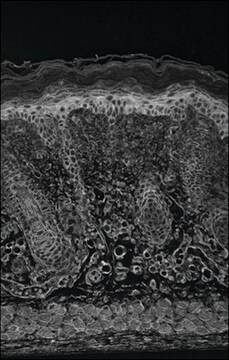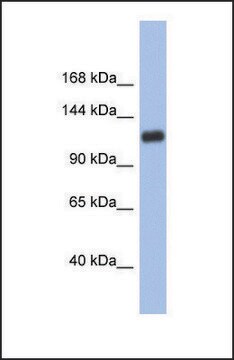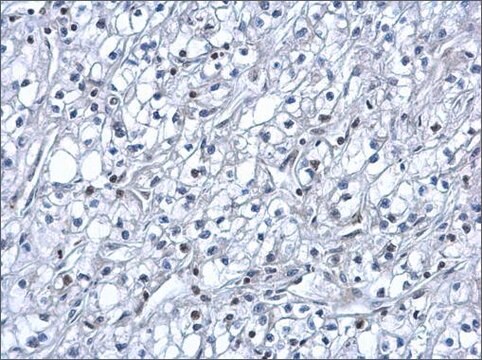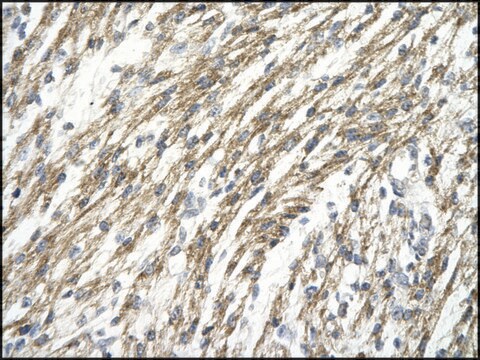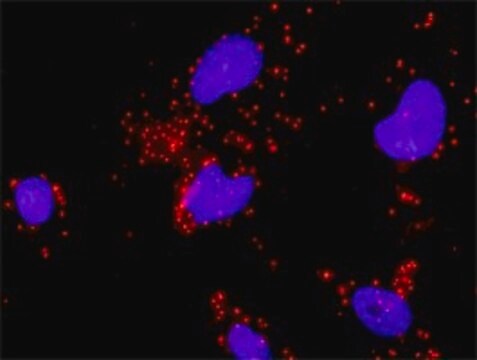추천 제품
생물학적 소스
mouse
Quality Level
결합
unconjugated
항체 형태
purified immunoglobulin
항체 생산 유형
primary antibodies
클론
H1α67, monoclonal
양식
buffered aqueous solution
분자량
antigen 120 kDa
종 반응성
rat, sheep, ferret, human, mouse
농도
~1 mg/mL
기술
immunohistochemistry (formalin-fixed, paraffin-embedded sections): 1:500-1:1,000 using antigen retrieval
immunoprecipitation (IP): suitable
western blot: 1:500-1:1,000
동형
IgG2b
UniProt 수납 번호
배송 상태
wet ice
저장 온도
−20°C
타겟 번역 후 변형
unmodified
유전자 정보
human ... HIF1A(3091)
mouse ... Hif1a(15251)
rat ... Hif1a(29560)
일반 설명
Hypoxia-inducible factor-1 (HIF-1) is a 120kD basic helix-loop-helix protein that belongs to the PAS superfamily of transcription factors. It has a crucial role in activating transcription of hypoxia-inducible genes. It can also activate the expression of the gene coding for NIP3; which subsequently induces cell apoptosis under persistent oxygen deprivation. Monoclonal anti-HIF-1α antibody can be used in immunostaining to detect HIF-1α localization. It can also be used in western blotting. Mouse anti-HIF-1α antibody reacts specifically with HIF1 α subunit of sheep, mouse, rat, ferret and human.
면역원
peptide corresponding to amino acids 432-528 of the human HIF-1α protein.
애플리케이션
Applications in which this antibody has been used successfully, and the associated peer-reviewed papers, are given below.
Immunohistochemistry (1 paper)
Immunohistochemistry (1 paper)
Monoclonal anti-HIF-1α antibody (diluted 1: 500) can be used in immunofluorescence confocal microscopy. It can also be used in in immunoblotting, immunoprecipitation and immunohistochemistry.
물리적 형태
Solution in 0.02 M phosphate buffer containing 0.25 M sodium chloride and 0.1% sodium azide.
면책조항
Unless otherwise stated in our catalog or other company documentation accompanying the product(s), our products are intended for research use only and are not to be used for any other purpose, which includes but is not limited to, unauthorized commercial uses, in vitro diagnostic uses, ex vivo or in vivo therapeutic uses or any type of consumption or application to humans or animals.
적합한 제품을 찾을 수 없으신가요?
당사의 제품 선택기 도구.을(를) 시도해 보세요.
Storage Class Code
10 - Combustible liquids
WGK
nwg
Flash Point (°F)
Not applicable
Flash Point (°C)
Not applicable
이미 열람한 고객
G L Semenza et al.
Kidney international, 51(2), 553-555 (1997-02-01)
Hypoxia-inducible factor 1 (HIF-1) is a basic helix-loop-helix protein that activates transcription of hypoxia-inducible genes, including those encoding: erythropoietin, vascular endothelial growth factor, heme oxygenase-1, inducible nitric oxide synthase, and the glycolytic enzymes aldolase A, enolase 1, lactate dehydrogenase A
Suchitra S Acharya et al.
Blood, 117(8), 2484-2493 (2010-12-18)
Joint arthropathy secondary to recurrent hemarthroses remains a debilitating complication of hemophilia despite the use of prophylactic factor concentrates. Increased vascularity and neoangiogenesis have been implicated in the progression of musculoskeletal disorders and tumor growth. We hypothesized that de novo
Jong Han Lee et al.
American journal of physiology. Endocrinology and metabolism, 304(10), E1035-E1041 (2013-03-21)
11β-Hydroxysteroid dehydrogenase type 1 (11β-HSD1) is involved in the pathogenesis of type 2 diabetes by generating active glucocorticoids (cortisol and corticosterone) that are strong inhibitors of angiogenesis. However, the mechanism of 11β-HSD1 gene expression and its relationship to adipose angiogenesis
Snider Desir et al.
Oncotarget, 7(28), 43150-43161 (2016-05-26)
In this study, we demonstrated that hypoxic conditions stimulated an increase in tunneling nanotube (TNT) formation in chemoresistant ovarian cancer cells (SKOV3, C200).We found that suppressing the mTOR pathway using either everolimus or metformin led to suppression of TNT formation
Lei Xiong et al.
The FEBS journal, 279(23), 4318-4326 (2012-10-09)
Several studies have identified a set of hypoxia-regulated microRNAs, among which is miR-210, whose expression is highly induced by hypoxia in various cancer cell lines. Recent studies have highlighted the importance of miR-210 and its transcriptional regulation by the transcription
자사의 과학자팀은 생명 과학, 재료 과학, 화학 합성, 크로마토그래피, 분석 및 기타 많은 영역을 포함한 모든 과학 분야에 경험이 있습니다..
고객지원팀으로 연락바랍니다.